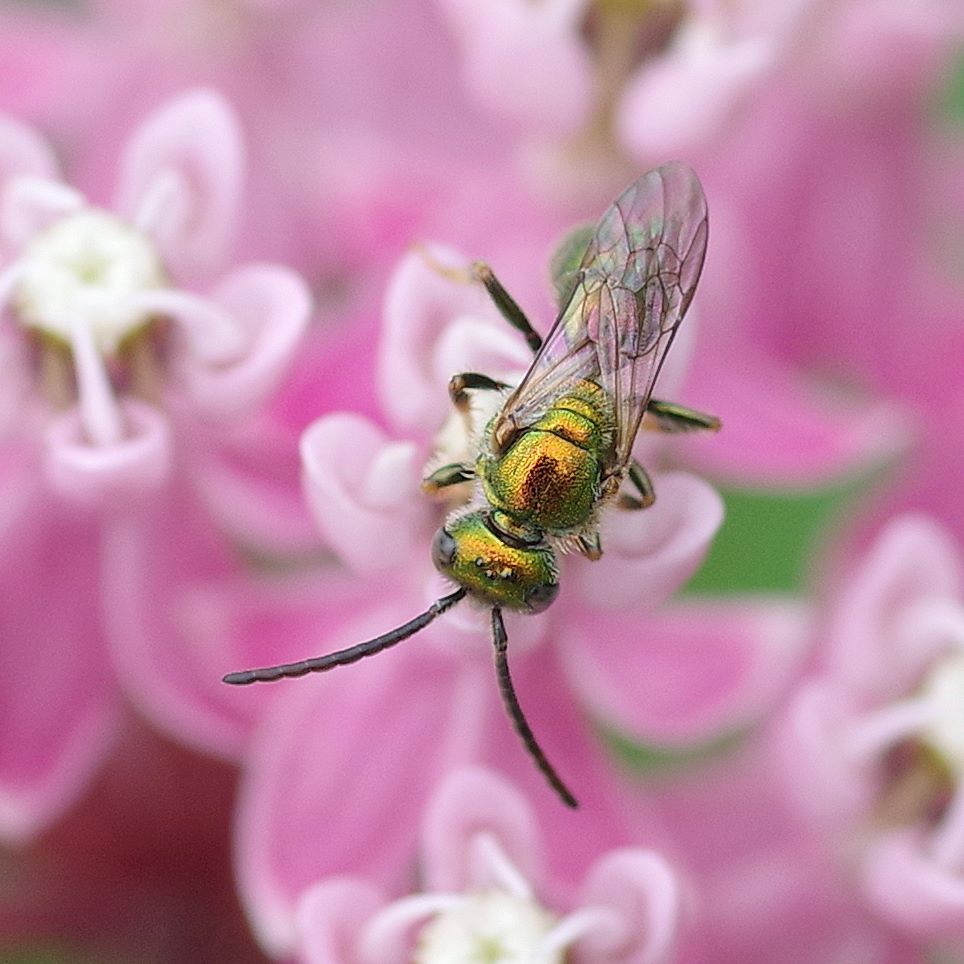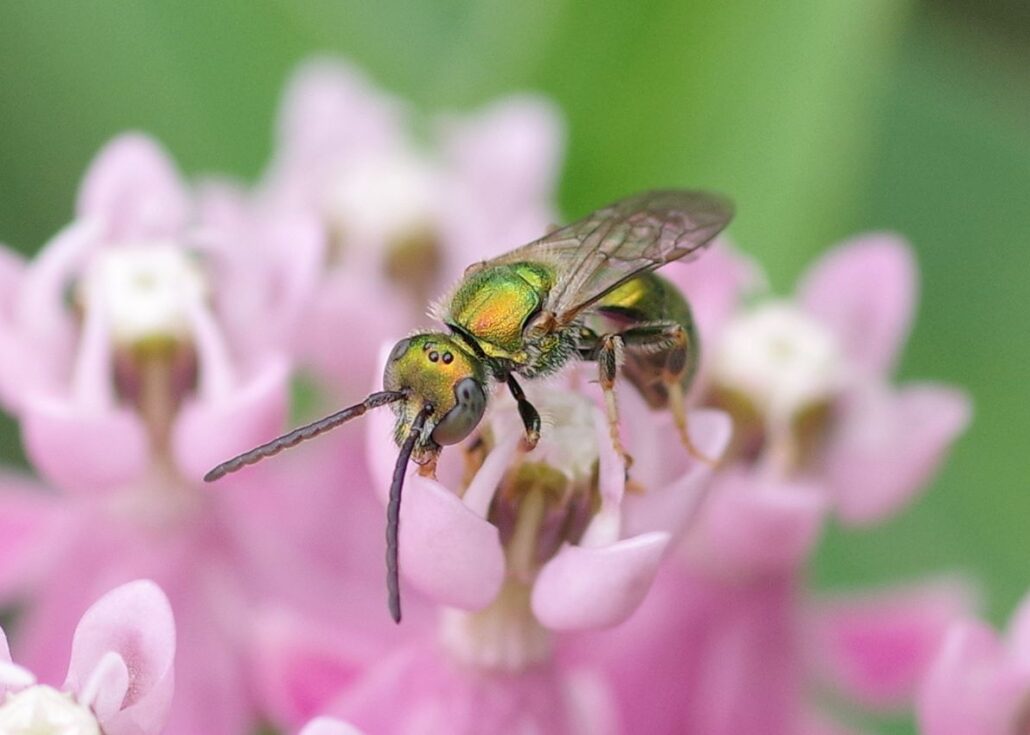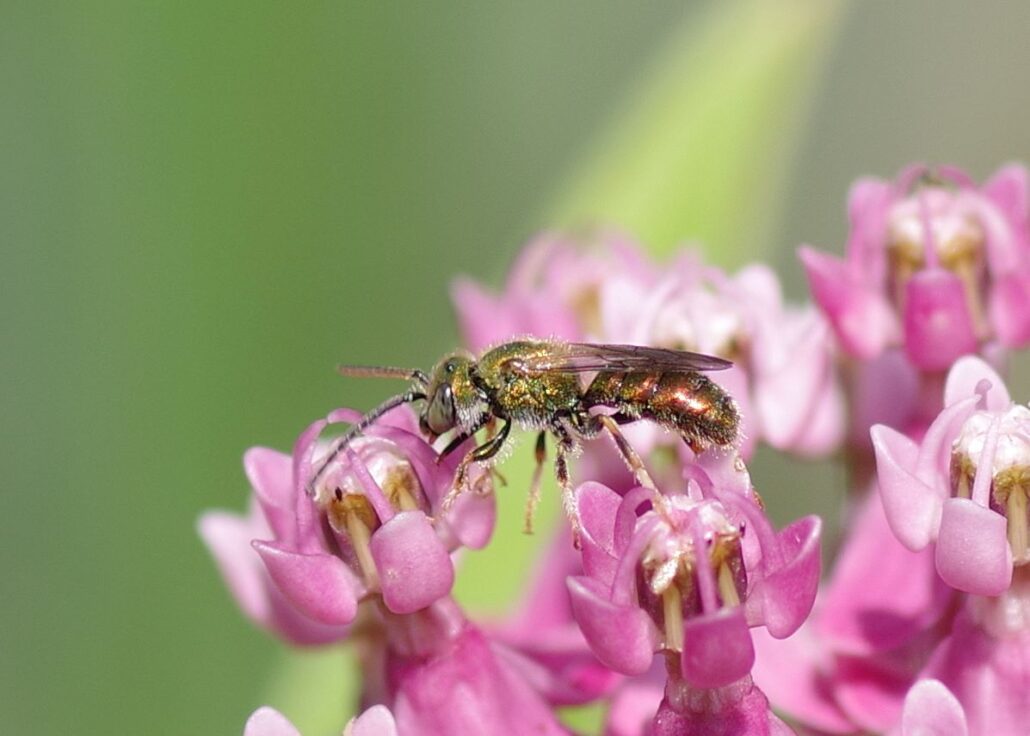
by Kate Redmond
Bug o’the Week Golden green sweat bee
Howdy, BugFans,
Wisconsin is home to between 500 and 600 species of wild bees, ranging in size from today’s sweat bee to bumble bees many times larger (there are about 4,000 bee species in the US). If a small brown or green bee landed on your arm and started sipping salt while you were working/sweating outside in the summer, you’ve met a sweat bee. Typically, no one is harmed in these encounters unless you brush the bee away roughly.
The BugLady’s husband was allergic to sweat bees, but when he went to the allergist to see if desensitization shots were available, the doctor said “What’s a sweat bee?” Which didn’t bode well for any shots.
Sweat bees can be a bear to differentiate (as one site warned, “Many species won’t be identifiable from photos”), and a microscope is needed to tell some species apart. Still, this is a seriously tiny sweat bee with an unusual color. So, the BugLady finds herself back out on that taxonomic limb again, but she’s gotten comfortable out there over the years, and she’s calling this one a Golden green sweat bee.
Golden green sweat bees (Augochlorella aurata) are one of about 100 species in Wisconsin in the family Halictidae, the Sweat, Furrow, Nomiine, and Short-faced Bees. Augochlor is a Greek prefix meaning “intensified gold-green,” and “aurata” means “gilded” or “golden.” Despite their name, most Golden green sweat bees are quite green https://bugguide.net/node/view/1894237/bgimage, but some are pinkish https://bugguide.net/node/view/1272175/bgimage, some are reddish https://bugguide.net/node/view/1124880/bgimage, some are blue https://bugguide.net/node/view/1180911/bgimage, and some are bi-colored https://bugguide.net/node/view/825764/bgimage. They are about one-fifth of an inch long, with females slightly longer than males.

Here are some Extreme Macros – https://www.usgs.gov/media/images/augochlorella-aurata-f-face-md-boonsboro (also available on eBay as a headshot), https://www.usgs.gov/media/images/augochlorella-aurata-f-back-md-boonesboro, and https://www.fws.gov/media/golden-green-sweat-bee-augochlorella-aurata.
They have a patchy northern range mostly east of the Rockies, and of the seven Augochlorella species in North America, Golden green sweat bees are found the farthest north. They are common in fields in eastern North America, where they are generalist pollinators that forage on flowers in a bunch of different plant families. Along with wildflowers, they also pollinate agricultural crops like apples, strawberries, alfalfa, tomatoes, and sunflowers. They carry pollen in hairs on their back legs https://bugguide.net/node/view/1306100/bgimage.

The vast majority of bees, including many of the Halicitdae and some of the Augochlorella, are solitary rather than communal bees – single Moms who create and provision egg chambers without the help of workers. Golden green sweat bees are flexible about the idea – at higher latitudes and altitudes (areas that have shorter growing seasons), they tend to be more solitary, but when they’re in warmer climes, they are called “primitively eusocial.” Eusocial describes the most advanced social behavior – think ant hill – characterized by cooperative brood care, overlapping generations within a colony, division of labor (castes), and reproductive and non-reproductive individuals.
In favorable climates, the fertile female overwinters and starts the colony in spring, excavating a nest tunnel (here are some diagrams of A. aurata nest tunnels https://actbeekeepers.asn.au/bee-buzz-box-july-2023-the-catacomb-part-iva-the-facultative-eusocia/figure-6-nesting-behaviour-of-facultatively-eusocial-augochlorella-aurata-1/), collecting pollen and fashioning it into pollen balls for her young, and laying six to eight eggs that will produce both males and females. Newly hatched males leave the nest, but newly-hatched females become workers that care for the queen. Later in the season, she produces another small batch of males and females that will fly out and mate in fall. A fertile female will dig down into the lowest/warmest part of the nest and hunker down until May, and the beat goes on.
Nest are dug in bare ground in woods and fields and can be as deep as 10 inches. The Vermont Center for Ecostudies Vermont Atlas of Life site included a picture of a nest entrance with a turret around the opening, but the BugLady didn’t find any other references to that behavior https://val.vtecostudies.org/wp-content/uploads/2021/05/A.-auratta-nest-SPH.jpeg
Neat picture of a Golden green sweat bee with a raindrop https://bugguide.net/node/view/33594/bgimage. About the picture, entomologist Eric Eaton wrote. “It might be that the rain dissolved honeydew that had accumulated on the leaf.”
Here’s a great source of information about bees, though not all NY bees appear here in Wisconsin, and vice versa https://www.sharpeatmanguides.com/wild-bee-id-guide-new-york. Check the Wild Bee ID guide tab.
Kate Redmond, The BugLady
Bug of the Week archives:
http://uwm.edu/field-station/category/bug-of-the-week/
